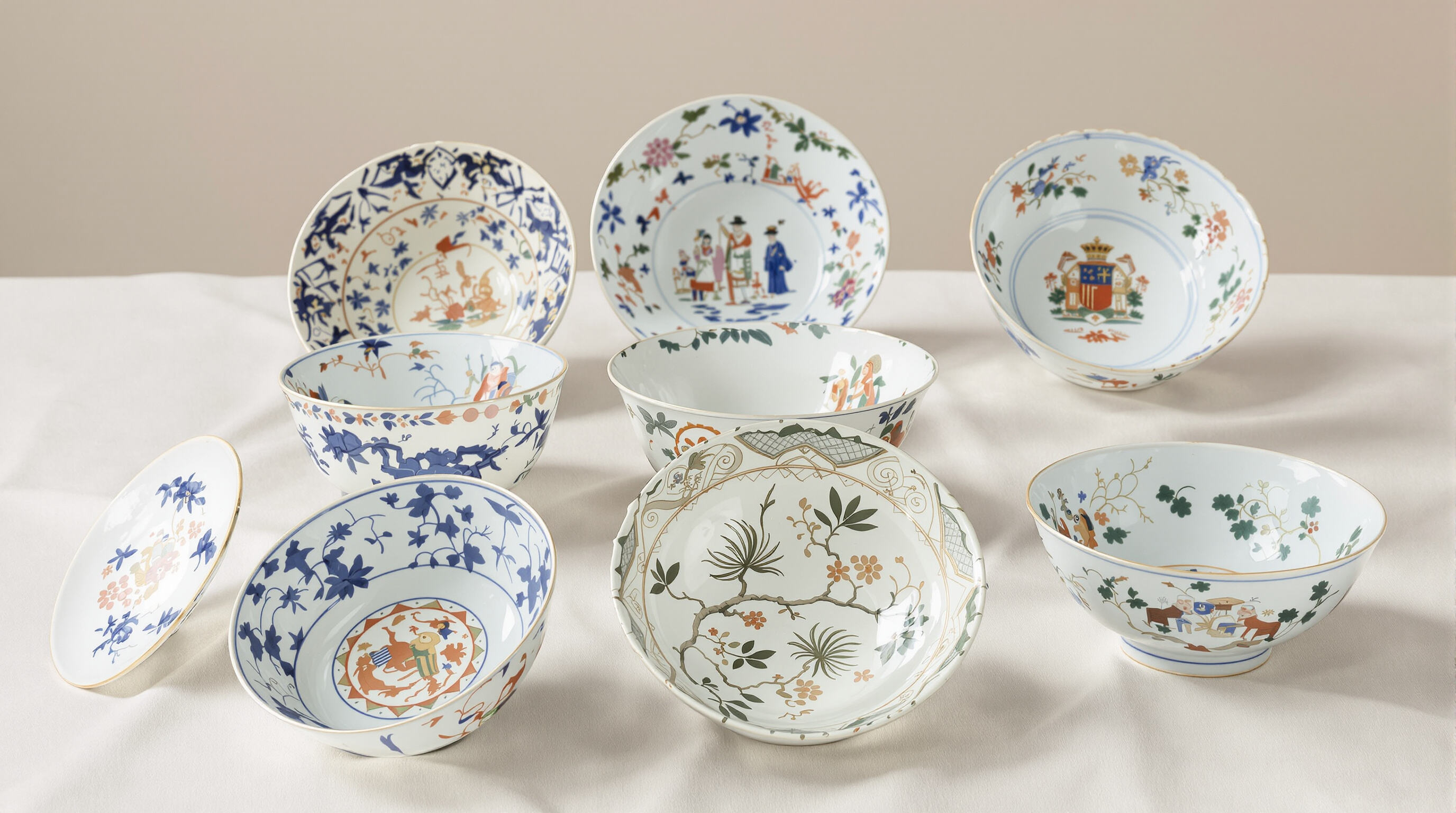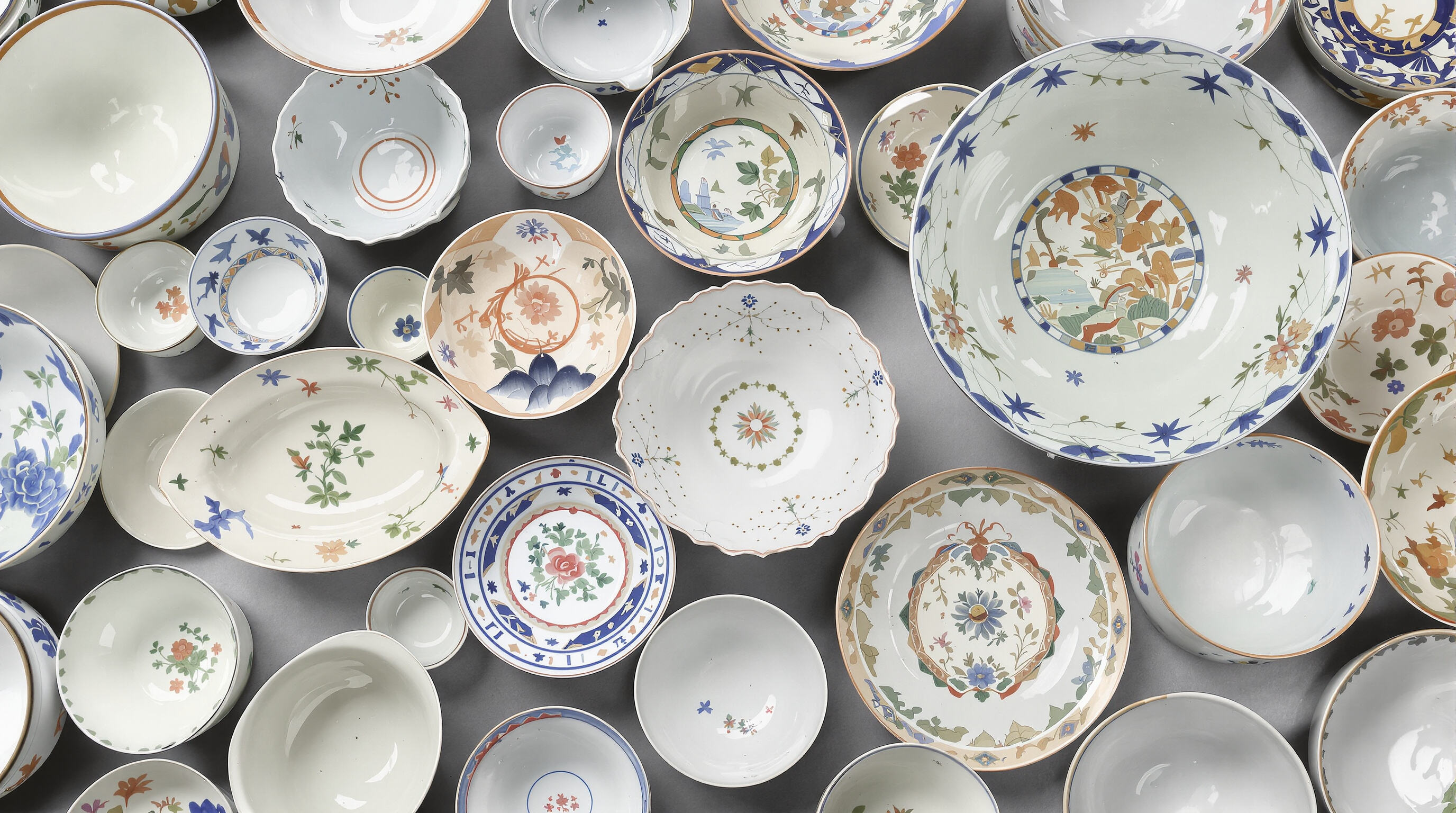Gabay sa Chinese Export Porcelain Bowls para sa mga Kolektor
Ang porcelana ay matagal nang isa sa mga pinakatanyag na kultural na iniluwas ng Tsina, na kinilala dahil sa kanyang gawa, kalinisan, at pangmatagalang kagandahan. Sa mga pinakatanyag na kategorya ay ang porcelana na iniluwas ng Tsina, na naging kilala noong panahon ng dinastiyang Ming at Qing kung kailan ginawa ang mga kalakal na ito nang eksklusibo para sa kalakalan sa Europa, Amerika, at iba pang bahagi ng Asya. Ngayon, hinahangaan ng mga kolektor sa buong mundo ang mga mangkok na porcelana na iniluwas ng Tsina dahil sa kanilang gawa, kasaysayan, at natatanging papel sa pag-uugnay ng Silangan at Kanluran.
Sa gabay na ito, tatalakayin natin ang kasaysayan, katangian, at mga tip sa pangongolekta ng mga mangkok na porcelana na iniluwas ng Tsina, upang matulungan ang mga mahilig na mas maunawaan ang kanilang kahalagahan at halaga.

Pinagmulan ng Porcelana na Iniluwas ng Tsina
Ang tradisyon ng porcelaine sa Tsina ay umaabot na sa libu-libong taon, ngunit ang merkado ng pag-export ay tunay na nagbunga mula pa noong ika-16 siglo. Noong panahon ng dinastiyang Ming, ang mga mangkok na porcelaine na may disenyo ng cobalt ay naging mahalaga sa buong Europa. Ang mga mangangalakal na Portuges ay kabilang sa mga unang nagdala ng mga elegante nitong produkto sa mga merkado sa Kanluran, sinusundan ng Kompaniyang Olandes na India, na naging mahalagang papel sa pagkalat ng porcelaine sa buong Europa.
Noong dinastiyang Qing, lalo na sa ilalim ng mga emperador na Kangxi, Yongzheng, at Qianlong, ang mga tindahan ng porcelaine sa Jingdezhen ay gumagawa ng malalaking dami ng mangkok na gawa upang umangkop sa panlasa ng Kanluran. Ang mga mangkok na ito ay madalas na pinagsasama ang tradisyonal na mga teknik ng Tsino sa mga motif na hinango sa mga panlasa sa dekorasyon ng Europa, tulad ng mga gulo ng bulaklak, mga crest ng armorial, at kahit mga tanawin ng arkitektura sa Kanluran.
Mga Natatanging Katangian ng mga Mangkok na Porcelaine para sa Pag-export
Ano ang nagpapahiwalay sa mga manggagawang manggagawang porcelana ng Tsina mula sa iba pang uri ng porcelana? Ang ilang mga katangian ay nangingibabaw:
1. Iba't ibang Disenyo
Ang mga manggagawang manggagawang porcelana ay madalas na nagpapakita ng isang kakaibang timpla ng mga motif na Tsino at Kanluranin. Ang mga karaniwang palamuti ay kinabibilangan ng mga dragon, phoenix, peonies, at mga tanawin ng kalikasan, kasama ang mga coat of arms ng Europa, mga eksena sa pangangaso, at mga imahe ng karagatan. Ang hybrid na estilo na ito ay sumasalamin sa palitan ng kultura noong panahong iyon.
2. Kalidad ng Glaze at Materyales
Ang matibay na luwad na kaolin mula sa Jingdezhen ay nagbigay sa mga manggagawang porcelana ng kanilang kaliwanagan, tibay, at makinis na tekstura. Ang malinaw at makintab na glaze ay nagsiguro ng mayamang palamuti at matagalang kaakit-akit, na naghihiwalay sa kanila mula sa mga lokal na ginawang kerso sa Europa.
3. Mga Hugis at Sukat
Samantalang ang tradisyunal na mga manggagawang Tsino ay ginawa para sa tsaa, kanin, o sabaw, ang mga bersyon naman para sa export ay may iba't ibang hugis at sukat upang umangkop sa kinaugalian ng ibang bansa sa pagkain. Ang ilan ay manipis at malaki para sa paghain ng mga dessert o punch, samantalang ang iba ay malalim para sa mga nilagang ulam at sabaw.
4. Mga Ispesyal na Teknik
Ang mga teknik gaya ng famille verte, famille rose, at blue-and-white underglaze ay naging partikular na popular sa mga manggagawang palayok. Ang famille rose na porcelaine, na may delikadong mga kulay rosas at pastel, ay lubhang paborito ng mga kolektor sa Europa noong ika-18 siglo.
Kasaysayan ng Importansya ng Porcelaine sa China
Ang mga manggagawang porcelaine mula sa China ay hindi lamang mga gamit na praktikal kundi pati na rin mga simbolo ng katayuan at palitan ng kultura. Sa Europa, madalas silang nagpalamuti sa mga mesa ng mga aristokrata at mangangalakal, na nagsisimbolo ng kayamanan at kagandahan. Sa Amerika, sila ay naging bahagi ng mga tahanan ng kolonya, at minsan ay may pasadyang disenyo na naglalaman ng mga crest ng pamilya o inisyal.
Ang mga manggagawa ay nakaimpluwensya rin sa mga tradisyon ng gawang-gawing kanluranin. Ang mga hurno sa Europa gaya ng Meissen sa Germany at Wedgwood sa England ay nagsikap na gayahin ang mga teknik ng China, na nagbigay daan sa kanilang sariling industriya ng porcelaine. Dahil dito, ang patuloy na pagkahumaling sa porcelaine ng China ay nakatulong sa paghubog ng pandaigdigang sining pangdekorasyon.
Pangongolekta ng Chinese Export Porcelain Bowls Ngayon
Para sa mga modernong kolektor, ang mga Chinese export porcelain bowl ay may parehong halagang pangkasan at kasaysayan. Narito ang ilang mahahalagang salik na dapat isaalang-alang:
Katapatan
Ang tunay na Chinese export porcelain bowl ay mayroong madalas na mga bahagyang imperpekto dahil sa gawaing kamay, bahagyang hindi pagkakapareho sa glaze, o mga marka ng kalan. Dapat maging maingat ang mga kolektor sa mga reproduksyon, na maaaring mukhang sobrang magkakapareho o artipisyal na nag-edad. Isang mabuting ideya na konsultahin ang mga mapagkakatiwalaang nagtitinda o mga bahay na nagpapasyahan upang kumpirmahin ang pagkakakilanlan.
Kalagayan
Ang kalagayan ay malaki ang epekto sa halaga. Ang mga bowl na may chips, bitak, o pagkumpuni ay karaniwang hindi gaanong ninanais, bagaman ang bihirang o mahalagang pangkasaysayan na piraso ay maaari pa ring mag-akit ng interes. Karamihan sa mga kolektor ay hinahangaan ang mga bagay na mayroon pa rin ng kanilang orihinal, maayos na napanatiling enamel at gilding.
Pinagmulan
Ang kasaysayan ng pagmamay-ari ng isang mangkok ay maaaring gawing higit na kaakit-akit. Ang dokumentasyon na nag-uugnay ng isang item sa isang kilalang pamilya, ari-arian, o koleksyon ay nagpapataas ng nais nito. Mahalaga lalo na ang pinagmulan para sa mga mangkok na porcelaine na may armorial, na kadalasang ipinapasadya para sa mga tiyak na European na sambahayan.
Bihira
Binabayaran ng mga kolektor nang higit para sa mga hindi pangkaraniwang hugis, bihirang disenyo, o mga disenyo na limitadong produksyon. Halimbawa, ang mga mangkok na eksport na mayroong mga eksena mula sa Bibliya sa Kanluran o mga sagisag na pampulitika ay lalong hinahanap ng mga kolektor.
Mga Tip sa Pagpapakita ng Mga Mangkok na Porcelaine na Ipinagbili sa Ibang Bansa
Dahil sa kanilang kagandahan at kahinaan, ang mga mangkok na porcelaine mula sa Tsina na ipinagbili sa ibang bansa ay karapat-dapat sa maalalang pagpapakita at pag-aalaga:
Gumamit ng mga Nagbibigay-Proteksyon na Suporta : Ilagay ang mga mangkok sa mga nakapadding na istand o loob ng mga kaso ng pagpapakita upang maiwasan ang aksidenteng pinsala.
Iwasan ang Direktang Liwanag ng Araw : Ang matagalang pagkakalantad ay maaaring maging sanhi ng pagkawala ng kulay ng enamel, lalo na sa mga kulay na 'famille rose'.
Matatag na Kapaligiran : Panatilihin ang mga mangkok sa mga lugar na may matatag na kahalumigmigan at temperatura upang maiwasan ang pagbitak ng glaze.
Pangkatin ayon sa Tema o Estilo : Ang pagpapakita ng mga koleksyon ayon sa motif, palette ng kulay, o dinastiya ay nagpapahusay ng visual impact at storytelling.
Ang Merkado para sa Porcelain na Ipinagbili ng Tsina
Matatag pa rin ang pandaigdigang merkado para sa porcelains na ipinagbili ng Tsina. Ang mga bahay na auction tulad ng Christie's at Sotheby's ay madalas na nagtatampok ng mga mangkok na porcelains na ipinagbili, kung saan ang mga bihirang halimbawa ay nagkakahalaga ng malaking halaga. Samantalang ang mga baguhan sa koleksyon ay maaaring makahanap ng abot-kayang mga piraso sa mga tindahan ng gamit na gamit o sa mas maliit na auction, ang mga mangkok na may kalidad para sa museo ay maaaring ibenta ng sampu-sampung libong dolyar.
Bukod dito, ang interes sa porcelains na ipinagbili ng Tsina ay lumago na sa Asya at Kanluran. Ang mga kolektor mula sa mainland China, Hong Kong, at Taiwan ay bawat taon ay nagbabalik ng mga yamang kultural na ito, na nagdaragdag sa demand at kompetisyon.
Bakit Hinahangaan ng mga Kolektor ang mga Mangkok na Porcelain na Ipinagbili
Ang nagpapahanga sa mga Chinese na ipinagbili ng porcelaine ay ang kanilang kakayahang magsalaysay ng kuwento. Bawat mangkok ay nagsasalaysay ng kuwento ng libu-libong taong kasanayan, kalakalan, at diyalogo ng kultura. Ang humawak ng isa ay mag-ugnay sa mga paglalakbay ng mga mangangalakal, artesano, at kolektor na naghubog sa kasaysayan ng mundo.
Kung ito man ay pinahahalagahan bilang palamuting sining, kasaysayang bagay, o paunana sa pamilya, ang mga mangkok na ito ay patuloy na naghihikayat ng paghanga. Para sa maraming kolektor, kinakatawan nila ang pinakamataas na antas ng kasanayan ng mga Intsik at ang kapanapanabik na pamana ng palitan ng kultura.
Kesimpulan
Nanatiling isa sa mga pinakapaboritong uri sa pangongolekta ng mga antigo ang Chinese na ipinagbili ng porcelaine. Mula sa kanilang pinagmulan sa mga hurno ng dinastiyang Ming hanggang sa kanilang pagkakaroon sa mga palasyo ng Europa at mga tahanan sa Amerika, ang mga pirasong ito ay nagpapakita ng kahanga-hangang kasanayan at kahalagahang pangkasaysayan. Para sa mga kolektor, nag-aalok sila hindi lamang ng kasiyahan sa pandinig kundi pati ng isang makikita at mahihipo na ugnayan sa daantaon ng pandaigdigang kalakalan at palitan ng kultura.
Sa pag-aaral ng kanilang kasaysayan, pagkilala sa mahahalagang katangian, at wastong pangangalaga, maaari para sa mga mahilig na makapagtayo ng mga koleksyon na magpapanatili sa mayamang pamana na ito para sa mga susunod na henerasyon.
✦ Shenzhen Tao Hui Industrial Co., Ltd. nagbibigay ng mga insight at ekspertisyo tungkol sa kapanapanabik na mundo ng tradisyunal na Tsino gawaing kamay at eksport na sining. Kung ikaw man ay isang may karanasang kolektor o nagsisimula pa lamang ang iyong paglalakbay, ang pag-unawa sa pamana ng mga eksport na porcelaine mangkok ng Tsina ay magpapalawak ng iyong pagpapahalaga at koleksyon.


